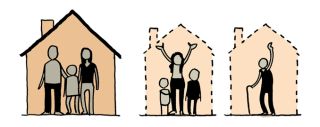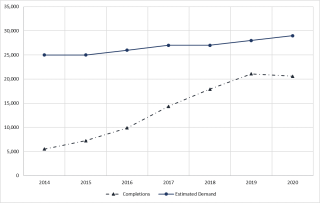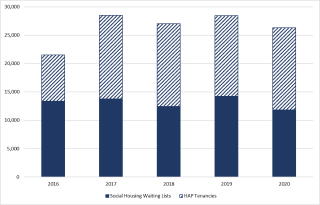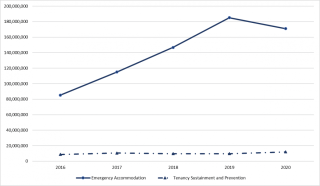Numbers not adding up in Housing for All

When the Government’s new housing strategy, Housing for All, was published, much was made of the targets to build 33,000 new homes every year, including 90,000 social homes over the period 2021 to 2030. But a look behind the data indicates that these targets are insufficient to meet the need.
Housing Need and Demand
The Government based this target on its Housing Need and Demand Assessments (HNDA)[1] and research conducted by the ESRI[2]. The difficulty is that these projections are based on new household formations and do not take account of the years of under-investment in the sector.
In 2014 the ESRI projected an ongoing need for at least 25,000 new dwellings a year over the following 15 years[3]. This estimate was revised the following year to approximately 27,000 new dwellings each year between 2016 and 2018, increasing year-on-year from 2018 to reach over 30,000 in 2024[4]. It is important to note that this and subsequent ESRI research in this area does not factor into account the full extent of housing delivery or ‘pent up demand’ and could therefore be considered a conservative estimate.
If we assume, on this basis, a demand of 25,000 in 2014 and 2015; a demand of 27,000 in 2016, 2017 and 2018; and an additional increase of 1,000 per annum for each of 2019 and 2020, total demand for new dwellings between 2014 and 2020 would reach 187,000 new homes. According to the CSO’s New Dwelling Completions Report, just 96,535 homes were constructed during this period, creating a ‘pent up demand’ of 90,465 homes (Chart 1).
Chart 1: Estimated Demand and New Dwelling Completions, 2014-2020

Source: Estimated Demand extracted from Bergin et al (2016): Ireland’s Economic Outlook Perspectives and Policy Challenges, ESRI: Dublin, p.46; New Dwelling Completions from CSO New Dwelling Completions Report Q1 2021, Table 1.
By only looking at future demand based on demographic projections, rather than ‘pent-up’ demand, the projections relied upon in Housing for All ignore the need of almost 90,500 households.
Social Housing
While the targets for overall housing provision are based on future demand only as underpinned by research, the targets for social housing don’t appear have any foundation at all. Housing for All commits to delivering 90,000 social homes by 2030, with an average of 9,500 new-build social homes per year to 2026.
If the strategy commits to building 47,500 by 2026, with guaranteed funding, how are the remaining 42,500 homes to be delivered? The reality is that almost half of the 90,000 homes will likely be delivered through the private sector using subsidies such as the Housing Assistance Payment (HAP) and Rental Accommodation Scheme (RAS).
But are the 90,000 socials homes sufficient? The short answer is no. There are currently 61,880 households on the social housing waiting lists, as of November 2020[5]. A further 59,821 households were in private rented tenancies supported by HAP as at Q4 2020[6]. With a failure rate of 26 per cent, HAP tenancies can hardly be classified as secure or sustainable[7]. Therefore the overall existing need for social housing is 121,701, more than the social housing provision target set out in Housing for All.
Chart 2 shows the number of new entrant households on both the social housing waiting lists and new HAP tenancies created in the years 2016 to 2020. From 2017 to 2020, the average number of new households entering the system was over 27,500 per year.
Chart 2: Households on the social housing waiting lists for 12 months or less and new HAP tenancies created each year, 2016-2020

Source: Department of Housing, Local Government and Heritage, Summary of Social Housing Needs Assessments, various years; Department of Housing, Local Government and Heritage, Overall Social Housing Provision, Housing Assistance Payment, Quarterly Reports, various years.
By ignoring current need, and not properly accounting for new entrants into the system, the social housing targets in Housing for All are doomed to fail those who need it most.
Homelessness
Housing for All commits to “working towards” eliminating homelessness by 2030 while simultaneously committing to increase resources for emergency homeless accommodation. A commitment to actually ending homelessness, and an increase in funding to actively prevent it, would have been a far better use of resources.
Between 2016 and 2020, the State has spent €703,428,403 on the provision of emergency homeless accommodation, not including long-stay and day services. In the same period, just €50,926,683 was spent on tenancy sustainment and homelessness prevention. While spending on emergency accommodation has more than doubled between 2016 and 2020, the level of spending on prevention has remained relatively static (Chart 3).
Chart 3: Spending on Emergency Homeless Accommodation and Tenancy Sustainment and Homeless Prevention

Source: Department of Housing, Local Government and Heritage, Local Authority Regional Financial Reports, various years.
Spending on emergency accommodation decreased slightly between 2019 and 2020, possibly as a result of measures to prevent evictions introduced as a result of the pandemic which kept people in their homes. Government must look to build on that and really commit to eliminating homelessness.
We welcomed many of the initiatives in our Review of Housing for All. However it is deeply disappointing that those most in need of a secure, sustainable home continue to be left behind.
[1]gov.ie - Housing Need and Demand Assessment (HNDA) (www.gov.ie)
[2]Regional demographics and structural housing demand at a county level (esri.ie)
[3]Executive Summary (esri.ie) p16
[5]gov.ie - Summary of Social Housing Assessments 2020 – Key Findings (www.gov.ie)
[6]gov.ie - Overall social housing provision (www.gov.ie)
[7]More than 1 in 4 HAP Tenancies not sustainable while real Social Housing need up 33% | Social Justice Ireland